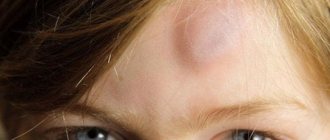The skull is made up of four main bones; when a fracture occurs at the base of the skull, one or more bones are broken. A fracture of the base of the skull is a very serious traumatic brain injury, quite often fatal to the victim. The mortality rate from a fracture of any skull bone is quite high, because the structures of the brain itself are often damaged.
Survival from this injury depends on how quickly the victim received first aid, hospitalization, and medical intervention. With skull fractures, a person develops profuse blood loss, which can cause death several hours after the injury occurs. If the injured person manages to survive, the consequences of a fracture of the base of the skull are not very good. Most likely, the person will be in a coma. The injury is considered especially serious in children. Being in a comatose state leads to disruption of important vital functions, mental abilities and disability for life. If there is only a crack in the skull, and there is no displacement of bone fragments, then there is no need for surgical intervention, and the patient has a good chance of a full recovery.
Causes
Damage to the base of the skull is very common:
- During the fall;
- From a strong blow to the head on a hard surface;
- In a traffic accident;
- From blows directly to the head.
In infants, damage to the skull is observed much less frequently, unlike in adults, since the child has mobile bones of the skull until the fontanelles fuse. When you hit your head, your baby's cranial bones overlap and compress.
Classification and types of skull fractures
Skull fractures are divided into several types depending on the mechanism of action and the nature of the damage. According to the mechanism, they are divided into direct and indirect. The former occur when force is applied to the site of bone damage (for example, when struck with a blunt object).
An indirect fracture occurs when the force of an impact passes from one part of the skull to another: for example, when falling down, when the impact falls on the pelvis or legs, the force of the impact is transferred through the trunk of the spine to the head, resulting in a skull fracture.
According to the nature of the bone fracture, they are distinguished:
- linear fractures are the least complex, in which superficial damage in the form of thin lines is observed;
- depressed – a dangerous type of injury, because parts of the bone penetrate the brain, causing brain damage;
- comminuted - partial destruction of the skull, which can damage the brain, causing a subdural hematoma, contusion or crushing of the brain;
- perforated fractures - occur as a result of bullet or shrapnel wounds.
In the preliminary diagnosis of TBI, a fracture of the skull bones is always suspected. An accurate diagnosis is made based on symptoms.
Mechanism of injury
When a fracture occurs at the base of the skull, a hole is created in the bone that protects the brain from the mouth, middle ear, eye sockets, nose and paranasal sinuses. Such damage to the integrity of bones is a type of penetrating wound. Cerebrospinal fluid begins to leak from the nose, mouth, or ears. Microbes living in the external environment penetrate the brain, infecting the intracranial contents.
When the skull bones are fractured in the area of the anterior part of the cranial fossa, blood flows into the conjunctiva, as well as into the tissue around the eyes, this phenomenon is called “raccoon eyes” or the “spectacles” symptom. In addition, blood and cerebrospinal fluid come from the nose. Air gets under the skin, which causes the development of subcutaneous emphysema.
Damage to the vault and base of the skull is often characterized by damage to the parts of the brain that are responsible for the mobility of the eyeballs, the sense of smell, as well as damage to the optic nerve process. A fracture of the calvarium with its base, when bone fragments damage the brain in deep areas, leads to amnesia, fainting and personality disorders.
Treatment of skull fracture
Conservative methods are most often chosen to treat patients with skull injuries. Bed rest is the main requirement. The patient's position should not be strictly horizontal; the flow of cerebrospinal fluid slows down if the head is located slightly higher than the body.
A basal skull fracture requires a lumbar puncture every 72 hours. At the same time, using subarachnoid insufflations, oxygen is introduced, equal in volume to the extracted fluid. Dehydration therapy is also carried out with the help of diuretics.
In addition to liquorrhea, the victim may develop pneumoencephaly. The accumulation of air over the hemispheres of the brain leads to a sharp increase in intracranial pressure. Carrying out a puncture through the superimposed burr hole allows the collected gas to be removed.
If a mild or moderately severe skull fracture is diagnosed, drug therapy includes painkillers: non-steroidal anti-inflammatory drugs are usually prescribed.
If there is a leakage of cerebrospinal fluid from the ears or nose, it means that the cerebrospinal fluid space is open to the entry of pathogenic bacteria. To prevent the development of a purulent infection, the patient is prescribed a course of antibiotics. Diacarb and Lasix are taken to suppress the production of cerebral fluid.
As a rule, the injury is accompanied by a bruise or concussion; in these cases, doctors prescribe the use of nootropics and vasotropic drugs, as well as drugs to improve cerebral circulation.
Types of damage
A fracture of the base of the skull occurs in one of the following types:
- Comminuted fracture of the base. The bone splits into several fragments, during which the outer shell of the brain, gray matter with blood vessels are damaged, resulting in dark bruises at the injured site and in nearby tissues. Brain contusion and crushing occurs. The bone becomes mobile. If, during a comminuted injury, the place where the sinuses connect is disrupted, the survival of the victim is almost zero.
- Linear skull fracture. This type of injury is the easiest; with such damage, bone fragments do not move and the injury can be mistaken for a concussion. Fracture lines heal on their own without medical assistance. However, a linear fracture of the occipital bone may cause symptoms that require some treatment.
- Depressed fracture of the arch or base. With such damage, the bone is pressed into the middle of the skull. Often, with this type of injury, internal structures are compressed and the outer meninges are damaged.
- Perforate fracture of the base or vault of the skull. Such injuries occur through gunshot wounds and are almost always fatal. The bullet passes through the head, causing brain destruction incompatible with life.
Recovery after injury
Recovery from an injury such as a basal skull fracture takes a long time. Recovery does not always occur fully. Combined injuries often leave behind a certain neurological deficit (loss or impairment of any function). Most often this is a violation of motor function (paresis or paralysis), loss of memory, hearing, speech impairment, etc.
However, the success of rehabilitation largely depends on the patient himself. In particular, on how accurately and correctly he carries out medical instructions. In this regard, the support of loved ones and relatives plays an important role.
The rehabilitation complex must necessarily include physical therapy, physiotherapeutic treatment methods, massage, and training on special simulators.
Sometimes recovery from injury requires the help of a highly qualified psychologist . This is not surprising, because every person is very worried about serious health problems, especially if they cause disability and disrupt their usual way of life.
You can read about skull fracture here.
Clinical picture
Symptoms of a fracture of the base of the skull and their severity depend on where the fracture is localized and how damaged the brain structures are. Immediately upon receiving damage, the person loses consciousness. Based on how severe the level of damage is, the victim may be unconscious for several minutes or fall into a prolonged coma.
Common symptoms of a fracture are as follows:
- headaches with a bursting character (occurs due to swelling of the brain tissue);
- bruising around the eyes;
- different pupil sizes;
- lack of reaction to light in the pupils;
- presence of vomiting;
- the appearance of nasal or ear liquorrhea (leakage of cerebrospinal fluid) and bleeding;
- urinary incontinence;
- heart rhythm failure;
- interruptions in blood pressure (up and down);
- the occurrence of confusion;
- agitated or inhibited behavior;
- violation of the respiratory system and circulatory system (if the brain stem is compressed).
A fracture of the base of the skull may have different signs in different places.
Temple pyramid
The fracture during damage to this area can have a longitudinal, transverse, diagonal appearance, or be combined with a separation of the top.
With a transverse fracture, the nerve processes of the face are paralyzed, the vestibular apparatus is disrupted, and a complete loss of taste and hearing occurs. During a longitudinal fracture, disturbances occur in the facial nerve canal and in the ears. In this case, hearing is partially lost, perforation occurs in the eardrum, and blood and cerebrospinal fluid flow from the ears. A hematoma occurs behind the ears and temples. Bleeding increases if the victim tries to move his head.
Anterior fossa of the skull
Symptoms typical of such damage are leakage of blood and cerebrospinal fluid from the nose. After a couple of days, bruises begin to form in the area around the eyes. If the cells that make up the ethmoid bone break, blisters appear under the skin - a manifestation of subcutaneous emphysema.
Middle fossa
Bleeding and liquorrhea from the ears during such damage develops only on one side due to the fact that the eardrum is perforated in one ear. Hearing may decrease or disappear completely. Hematoma occurs on the temple and in the area behind the ear. The facial nerve is damaged and the sense of taste is impaired.
Diagnostics
The diagnostic algorithm for all victims with traumatic brain injury is approximately the same and consists of several steps.
- Collecting complaints and studying medical history.
- General and specialized examination of the patient.
- Application of additional diagnostic methods.
The results of the patient survey and examination are given above. Additional diagnostic methods include lumbar puncture, computed tomography and magnetic resonance imaging.
MRI examination will help to conduct a detailed diagnosis
Lumbar puncture allows you to assess the level of intracranial pressure, the presence of subarachnoid hemorrhage, and the addition of a secondary infection. According to indications, this study is carried out over time to monitor the effectiveness of treatment.
Computed tomography and magnetic resonance imaging are today the most accurate non-invasive techniques that allow visualization of the bones of the skull and all parts of the brain. Suspicion of a fracture of the base of the skull is a direct indication for a CT scan. After stabilization of the patient's condition, an MRI is indicated. It makes it possible to assess the presence and extent of brain damage.
First aid
First aid for a skull fracture always begins with calling an ambulance, since every minute counts. Next, the victim is placed on a hard surface. The position of the victim should be on his back, with a slight turn to the side. The head is fixed in a motionless state. The chest area should also be fixed. A small cushion is placed under the victim’s back to prevent him from rolling back. This is necessary to prevent vomit from entering the victim’s respiratory tract.
A bandage with an antiseptic solution should be applied to the site of skin damage, to which a cold compress should be applied. Cold helps to relieve some of the pain and swelling that has arisen, and will also prevent the occurrence of a very large hematoma. The victim's tight clothing is carefully removed or unbuttoned; if present, glasses, jewelry, and dentures are removed. In case of pain that cannot be tolerated, you should resort to taking a painkiller if the victim has not lost consciousness.
An unconscious person should not be given any oral medications.
In the presence of acute respiratory failure, it is necessary to perform artificial respiration, as well as administer drugs to normalize the functioning of the heart - glucose and Lasix. If severe blood loss occurs and blood pressure drops sharply, then instead of Lasix, polyglucin is administered intravenously. If there is strong muscle excitation, intramuscular injection of suprastin is necessary.
Painkillers should be used carefully as they may increase blood loss. Narcotic painkillers cannot be administered, as they lead to impaired respiratory function. You should act without panic, remembering that the life of the victim depends on the provision of first aid.
First aid for a fracture of the base of the skull
At the slightest suspicion of a head injury, you should urgently call an ambulance. A fracture of the base of the skull bone poses an immediate threat to human life and health, so every minute counts.
Before the ambulance team arrives, the victim must be provided with first aid . It includes the following activities:
- If a person has clouding of consciousness, care must be taken to give the body a stable position on its side. This is necessary in order to avoid aspiration (swallowing) of vomit.
- Examine the wound. If there is bleeding, then you should try to stop it. In most cases, a pressure bandage is sufficient for this.
- It is important to provide the victim with fresh air. To do this, you need to unbutton your collar (untie your tie, scarf, etc.).
- If possible, you need to perform an initial cleansing of the wound and treat it with an antiseptic solution (for example, hydrogen peroxide). If there is nothing at hand, the wound surface should be covered with a dry, clean cloth.
- It is important to ensure that the person does not move. Otherwise, secondary displacement of bone fragments may occur and the severity of the injury will worsen.
- A heating pad with ice can be used as a pain reliever. Before applying to the skin, it must be wrapped in a dry towel to avoid frostbite.
Treatment
During treatment, doctors do everything to prevent the development of purulent processes inside the skull. The patient is prescribed antibacterial therapy, the cavity of the middle ear and nasopharynx is sanitized using antibacterial drugs. Therapy is carried out conservatively or through surgery, depending on the severity of the injury.
Possible consequences
The consequences of a fracture largely depend on the severity of the injury and associated complications. They can be either direct or remote in time. Direct ones occur immediately at the time of injury. These include:
- Intracerebral hematoma. A small accumulation of blood can resolve on its own. When the blood clot is large, the brain tissue is compressed.
- Damage to brain tissue can lead to loss of vision or hearing, and breathing problems cannot be ruled out.
- Purulent infection. Pathogenic microorganisms provoke inflammation of the meninges, encephalitis and abscesses.
It is rare that a fracture of the bones of the base of the skull goes away without leaving a trace. Trauma is fraught with impaired speech, vision and hearing, loss of the ability to self-care, and the subsequent development of Alzheimer's disease.
Long-term consequences differ from direct ones in that they occur some time after the injury. They can appear either after a month or after 5 years. This is due to insufficient restoration of damaged brain tissue and the formation of scars at the fracture site, which subsequently compress the vessels and nerves in the brain. The most common long-term consequences:
- epilepsy;
- encephalopathy;
- paralysis;
- paresis;
- cerebral hypertension;
- stroke;
- mental disorders.
As for the life prognosis for the victim, survival depends on the severity of the fracture and the speed of medical care. With single cracks and no signs of displacement or purulent complications, the prospects are favorable. Secondary infection provokes future epileptic seizures, the development of frequent headaches, encephalopathy, and an increased risk of stroke.
If the fracture was accompanied by massive blood loss, then death soon after the injury cannot be ruled out. Sometimes severe trauma leads to coma, which has a poor outcome. In such patients, mental activity is most often impaired, and vital functions are partially lost, and the victim remains disabled. Timely, qualified assistance will help, if possible, avoid serious consequences for the patient.
Forecast
The patient’s future life depends on how severe the injury was, what complications there were after it, and how the treatment worked. With the development of infectious complications, for example, when meningitis or encephalitis occurs, encephalopathy, persistent hypertension, chronic migraines and epilepsy can occur.
Almost always, during an injury, severe blood loss occurs, which sometimes causes death, or coma, the outcome of which is also not favorable. If the bleeding is not very large, then intracerebral hematomas may occur.
Consequences and survival
The consequences of injuries to bones and brain tissue significantly affect the quality of life. A fracture of the skull bones often causes disability. It is customary to distinguish between complications that occur immediately after injury and over time. The category of direct complications includes:
- intracranial hemorrhages;
- damage to brain tissue, blood vessels and nerves;
- infectious processes in the cranial cavity.
Trauma to brain tissue will always be accompanied by rupture of blood vessels. Large hematomas disrupt brain function with their pressure. Damage to the nerves causes loss of hearing, vision, smell, and sensitivity. The development of infection in the wound contributes to the onset of inflammatory diseases of the brain. Encephalitis, meningitis, and brain abscesses are severe complications of such injuries.
A linear skull fracture has long-term consequences. This type of fracture is common in children and accounts for more than two-thirds of skull injuries. The category of long-term consequences is:
- encephalopathy;
- epilepsy attacks;
- paresis and paralysis;
- cerebral hypertension.
The cause of such complications is the formation of scar tissue and impaired regeneration of damaged nerves. The malignant course of hypertension leads to stroke. Over time, personality changes appear.
Complicated fractures are characterized by an extremely serious condition and unpredictable consequences. Death is possible at any stage of treatment and rehabilitation. Rehabilitation therapy for such injuries lasts for years. For some patients, returning to a full life is impossible.











